A Method for Reducing Sub-Divisional Errors in Open-Type Optical Linear Encoders with Angle Shift Pattern Main Scale
Abstract
:1. Introduction
2. Materials and Methods
2.1. Working Principle of Open-Type Optical Linear Encoder
2.2. Theoretical Investigation for SDE Reduction
2.3. The Fabrication Method of the Proposed Main Scale
2.3.1. Maskless Lithography System
2.3.2. The Process of Fabrication
3. Experimental Setup
- Computer with control software;
- ACS servo drive;
- Planar XY linear stage;
- Reading head and main scales;
- IC-Haus SinCosYzer.
4. Experiment Results and Discussion
- Correlation between harmonic suppression and SDE reduction: Under specific conditions where DC-offset, signal amplitudes, and orthogonality are carefully controlled, a notable correlation is observed. The successful suppression of the third order harmonic demonstrates a strong correlation with the reduction in SDE. This finding underscores the importance of harmonic control in achieving fine precision in optical linear encoders.
- Significance of SDEs in achieving higher resolution: Beyond the established threshold of SDEs, the pursuit of increased resolution in an optical linear encoder becomes impractical. For advanced industrial applications, high-resolution demands often lead to the utilization of costly displacement sensors, such as laser interferometers. The method proposed in this research presents a promising avenue for developing ‘high-end’ displacement sensors at a more cost-effective scale, potentially benefiting precision equipment across various industries.
- Challenges in practical industrial environments: In industrial environments, factors such as vibrations, electromagnetic interference, and temperature fluctuations are prevalent. These factors have the potential to significantly influence SDE, potentially undermining the accuracy of optical linear encoders. It is noteworthy that the SDE data presented in this investigation is obtained under controlled laboratory conditions. Subsequent research endeavors will explore the impact of real-world industrial factors on the efficacy of the proposed method, validating the robustness in practical applications. The investigation can contribute valuable insights into the method’s performance in diverse and challenging operational conditions.
- The proposed DMD maskless lithography technology, while ideal for academic research and experimental purposes, may encounter challenges in mass-producing long-range main scales. The maximum exposure length of the main scale is constrained by the travel range of the motion platform. The implementation of long-range fabrication requires a costly motion platform. A cost-effective strategy involves using DMD maskless lithography technology to create masks, combining them with high-precision probes to extend the mask’s range. Subsequently, the contact exposure approach can be applied for the mass production of long-range main scales.
- The potential applicability of the proposed method extends to other types of optical encoder, such as the enclosed-type optical linear encoder and the open-ring-type angular encoder to reduce SDEs. In the case of enclosed-type optical linear encoders, the inclusion of additional phase lines on the index grating is unnecessary, as mechanical systems ensure a fixed distance between the index grating and the main grating. Consequently, it is more convenient to implement the suggested patterns on the index grating rather than on the main scale.
5. Conclusions
Author Contributions
Funding
Data Availability Statement
Conflicts of Interest
References
- Peng, K.; Yu, Z.; Liu, X.; Chen, Z.; Pu, H. Features of Capacitive Displacement Sensing That Provide High-Accuracy Measurements with Reduced Manufacturing Precision. IEEE Trans. Ind. Electron. 2017, 64, 7377–7386. [Google Scholar] [CrossRef]
- Das, S.; Sarkar, T.S. A New Method of Linear Displacement Measurement Utilizing Grayscale Image. IJEEE 2013, 1, 176–181. [Google Scholar] [CrossRef]
- Miyajima, H.; Yamamoto, E.; Yanagisawa, K. Optical Micro Encoder with Sub-Micron Resolution Using a VCSEL. Sens. Actuators A Phys. 1998, 71, 213–218. [Google Scholar] [CrossRef]
- Seybold, J.; Bülau, A.; Fritz, K.-P.; Frank, A.; Scherjon, C.; Burghartz, J.; Zimmermann, A. Miniaturized Optical Encoder with Micro Structured Encoder Disc. Appl. Sci. 2019, 9, 452. [Google Scholar] [CrossRef]
- Engelhardt, K.; Seitz, P. High-Resolution Optical Position Encoder with Large Mounting Tolerances. Appl. Opt. 1997, 36, 2912. [Google Scholar] [CrossRef] [PubMed]
- Moers, A.J.M.; van Riel, M.C.; Bos, E.J. Design and Verification of the TriNano Ultra Precision CMM; Ilmenau University Library: Ilmenau, Germany, 2011. [Google Scholar]
- Cerón Viveros, M.F.; Rojas Arciniegas, A.J. Development of a Closed-Loop Control System for the Movements of the Extruder and Platform of a FDM 3D Printing System. NIP Digit. Fabr. Conf. 2018, 2018, 176–181. [Google Scholar] [CrossRef]
- Shin, B.; Jeon, S.; Lee, J.; Han, C.S.; Im, C.M.; Kwon, H.-J. Controlled Trigger and Image Restoration for High Speed Probe Card Analysis. Int. J. Precis. Eng. Manuf. 2015, 16, 661–667. [Google Scholar] [CrossRef]
- Mishra, S.; Coaplen, J.; Tomizuka, M. Precision Positioning of Wafer Scanners Segmented Iterative Learning Control for Nonrepetitive Disturbances [Applications of Control]. IEEE Control. Syst. 2007, 27, 20–25. [Google Scholar]
- Position Control in Lithographic Equipment [Applications of Control]. IEEE Control Syst. 2011, 31, 28–47. [CrossRef]
- Available online: https://www.rsf.at/wp-content/uploads/downloads/MS_25-EN.pdf (accessed on 20 January 2024).
- Qiao, D.; Xu, Z.; Wu, H.; Zeng, Q.; Liu, Y.; Sun, Q. A Method for Compensating Interpolation Error of Absolute Linear Encoder. Acta Opt. Sin. 2015, 35, 0112008. [Google Scholar] [CrossRef]
- Haitjema, H. The Calibration of Displacement Sensors. Sensors 2020, 20, 584. [Google Scholar] [CrossRef]
- Balemi, S. Automatic Calibration of Sinusoidal Encoder Signals. IFAC Proc. Vol. 2005, 38, 68–73. [Google Scholar] [CrossRef]
- Požar, T.; Gregorčič, P.; Možina, J. A Precise and Wide-Dynamic-Range Displacement-Measuring Homodyne Quadrature Laser Interferometer. Appl. Phys. B 2011, 105, 575–582. [Google Scholar] [CrossRef]
- Tan, K.K.; Tang, K.-Z. Adaptive Online Correction and Interpolation of Quadrature Encoder Signals Using Radial Basis Functions. IEEE Trans. Contr. Syst. Technol. 2005, 13, 370–377. [Google Scholar] [CrossRef]
- Dhar, V.K.; Tickoo, A.K.; Kaul, S.K.; Koul, R.; Dubey, B.P. Artificial Neural Network-Based Error Compensation Procedure for Low-Cost Encoders. Meas. Sci. Technol. 2010, 21, 015112. [Google Scholar] [CrossRef]
- Kavanagh, R.C. Probabilistic Learning Technique for Improved Accuracy of Sinusoidal Encoders. IEEE Trans. Ind. Electron. 2001, 48, 673–681. [Google Scholar] [CrossRef]
- Ye, G.; Liu, H.; Wang, Y.; Lei, B.; Shi, Y.; Yin, L.; Lu, B. Ratiometric-Linearization-Based High-Precision Electronic Interpolator for Sinusoidal Optical Encoders. IEEE Trans. Ind. Electron. 2018, 65, 8224–8231. [Google Scholar] [CrossRef]
- Tan, K.; Zhou, H.X.; Lee, T.H. New Interpolation Method for Quadrature Encoder Signals. IEEE Trans. Instrum. Meas. 2002, 51, 1073–1079. [Google Scholar] [CrossRef]
- Hane, K.; Endo, T.; Ito, Y.; Sasaki, M. A Compact Optical Encoder with Micromachined Photodetector. J. Opt. A Pure Appl. Opt. 2001, 3, 191–195. [Google Scholar] [CrossRef]
- Ieki, A.; Hane, K.; Yoshizawa, T.; Matsui, K.; Nashiki, M. Optical Encoder Using a Slit-Width-Modulated Grating. J. Mod. Opt. 1999, 46, 1–14. [Google Scholar] [CrossRef]
- Yang, F.; Lu, X.; Kilikevičius, A.; Gurauskis, D. Methods for Reducing Subdivision Error within One Signal Period of Single-Field Scanning Absolute Linear Encoder. Sensors 2023, 23, 865. [Google Scholar] [CrossRef]
- Lu, X.; Kilikevičius, A.; Yang, F.; Gurauskis, D. A Method to Improve Mounting Tolerance of Open-Type Optical Linear Encoder. Sensors 2023, 23, 1987. [Google Scholar] [CrossRef]
- Rozman, J.; Pletersek, A. Linear Optical Encoder System with Sinusoidal Signal Distortion Below −60 dB. IEEE Trans. Instrum. Meas. 2010, 59, 1544–1549. [Google Scholar] [CrossRef]
- Fursenko, A.; Kilikevičius, A.; Kilikevičienė, K.; Borodinas, S.; Kasparaitis, A.; Gurauskis, D. Experimental Investigation of Friction Transition on Vibration of Steel Tapes. In AIP Conference Proceedings, Yogyakarta, Indonesia, 29 October 2018; AIP Publishing: College Park, MA, USA, 2018; p. 020016. [Google Scholar]
- Merino, S.; Retolaza, A.; Juarros, A.; Landis, S. A New Way of Manufacturing High Resolution Optical Encoders by Nanoimprint Lithography. Microelectron. Eng. 2007, 84, 848–852. [Google Scholar] [CrossRef]
- Goudarzi Khouygani, M.H.; Jeng, J.-Y. High-Precision Miniaturized Low-Cost Reflective Grating Laser Encoder with Nanometric Accuracy. Appl. Opt. 2020, 59, 5764. [Google Scholar] [CrossRef] [PubMed]
- Pletersek, A.; Benkovic, R.; Trontelj, J. Interpolation Method and Frequency Independent Peak Amplitude Measurement of Orthogonal—Periodic Signals. Recent Pat. Eng. 2011, 5, 82–93. [Google Scholar] [CrossRef]
- Lee, B. Introduction to ±12 Degree Orthogonal Digital Micromirror Devices (DMDs); Texas Instruments: Dallas, TX, USA, 2008. [Google Scholar]


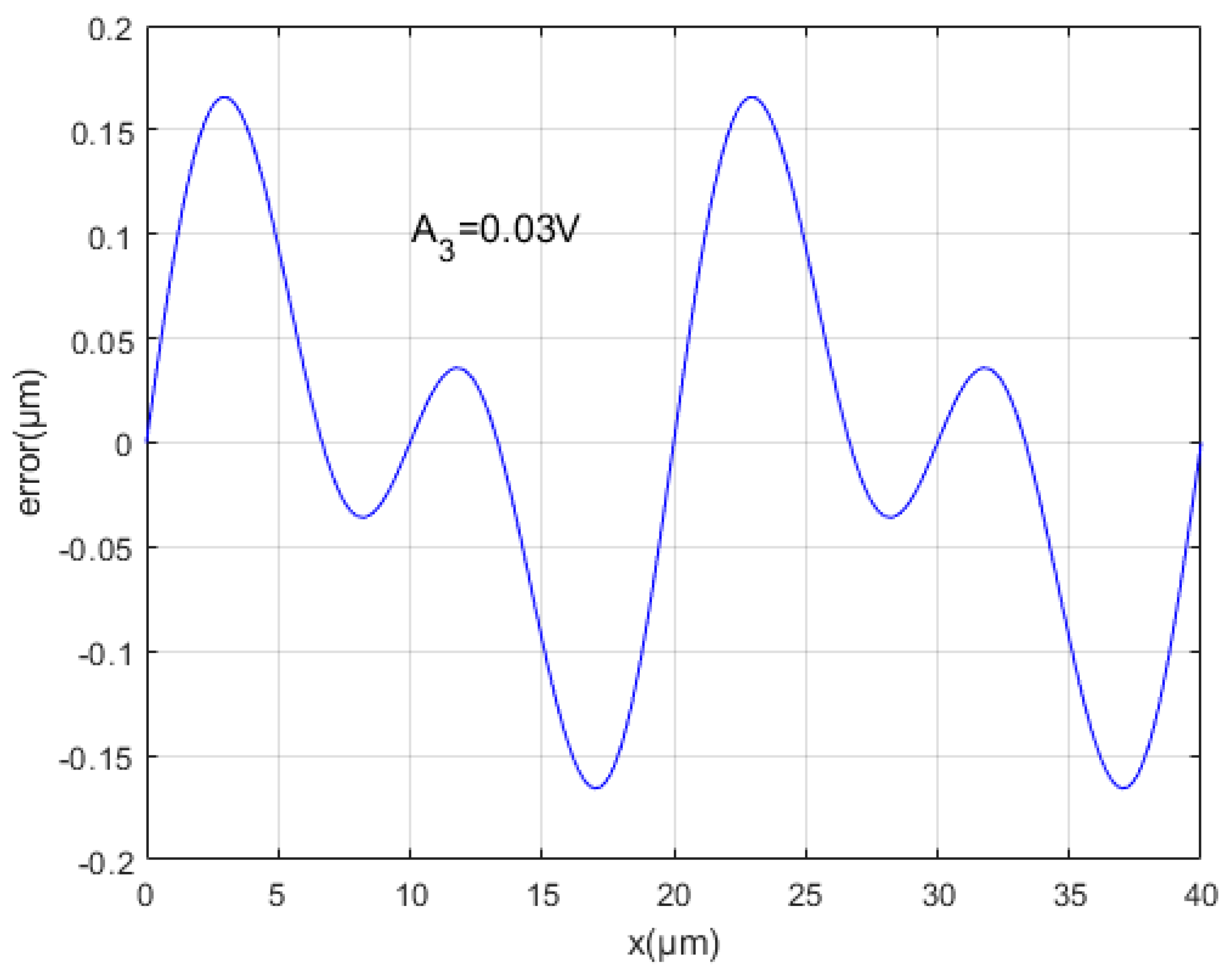
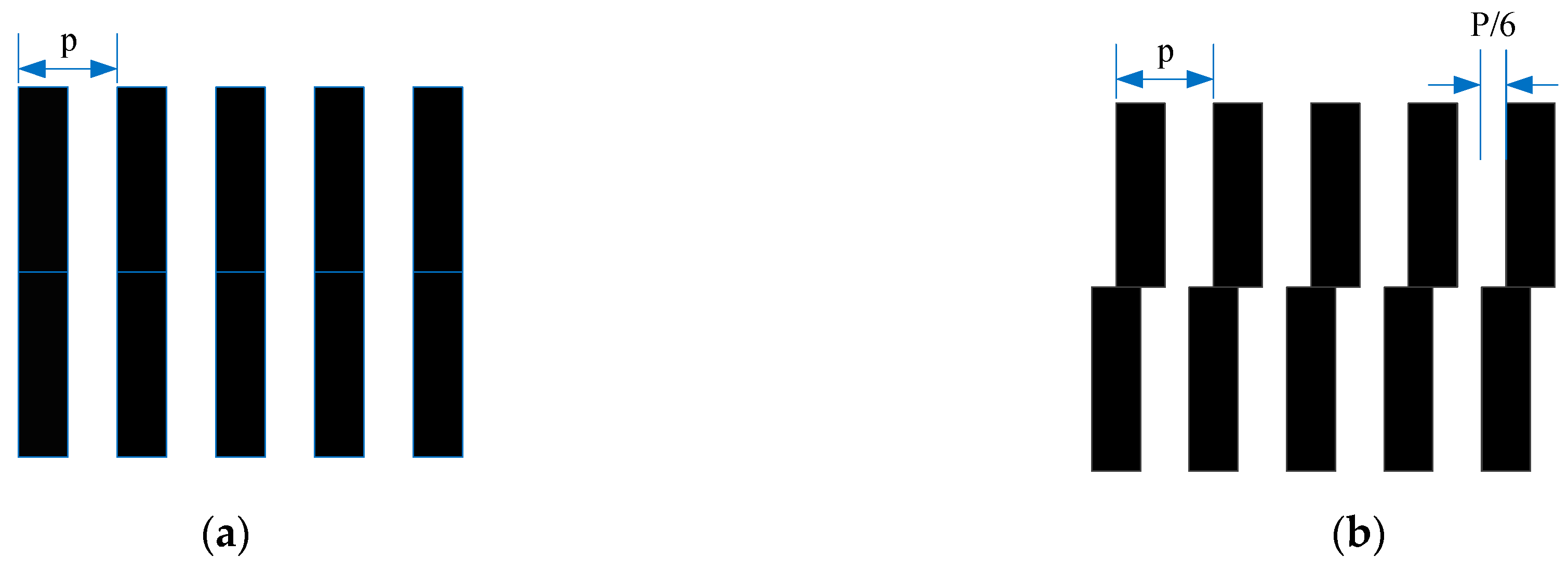
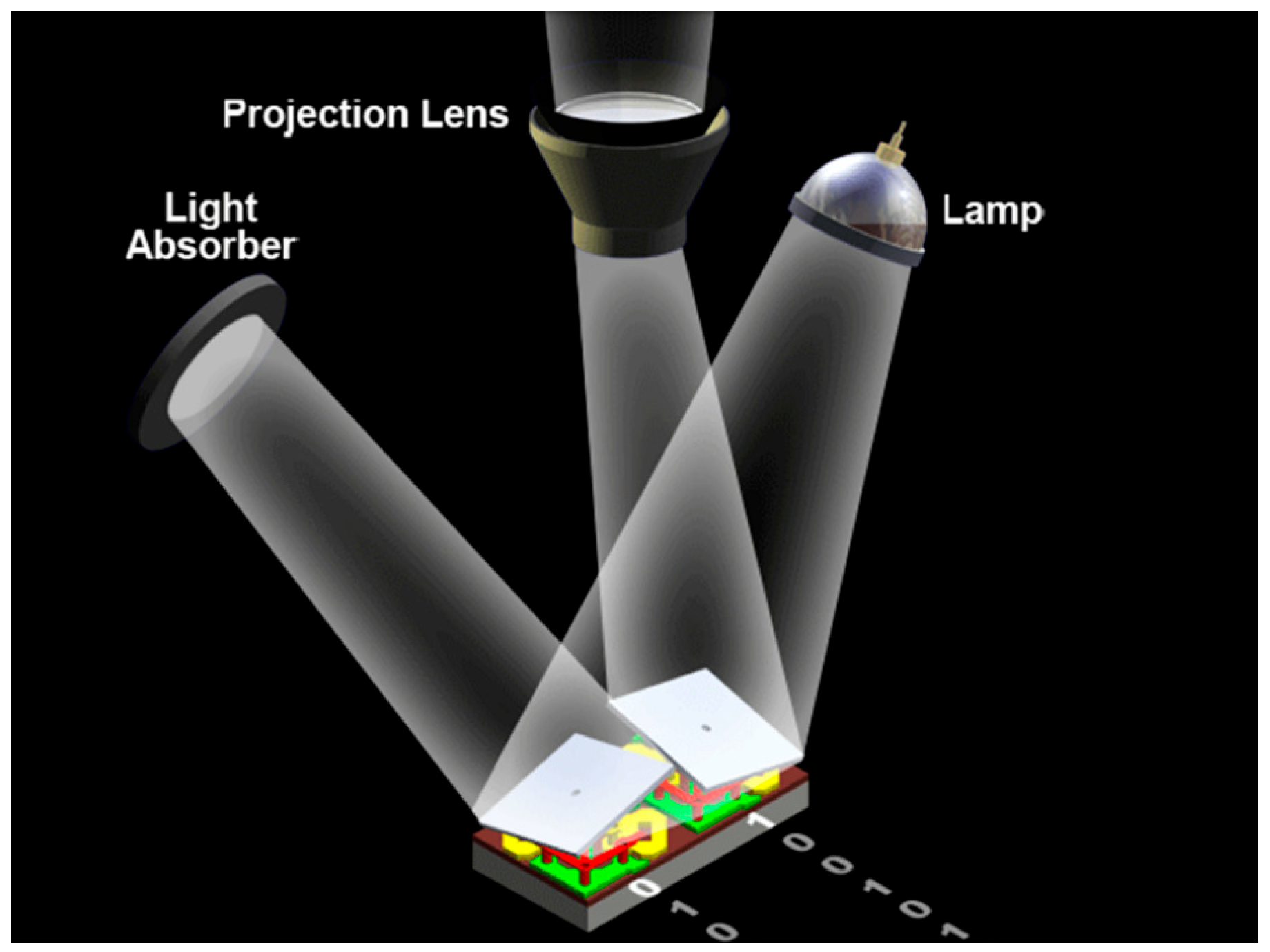

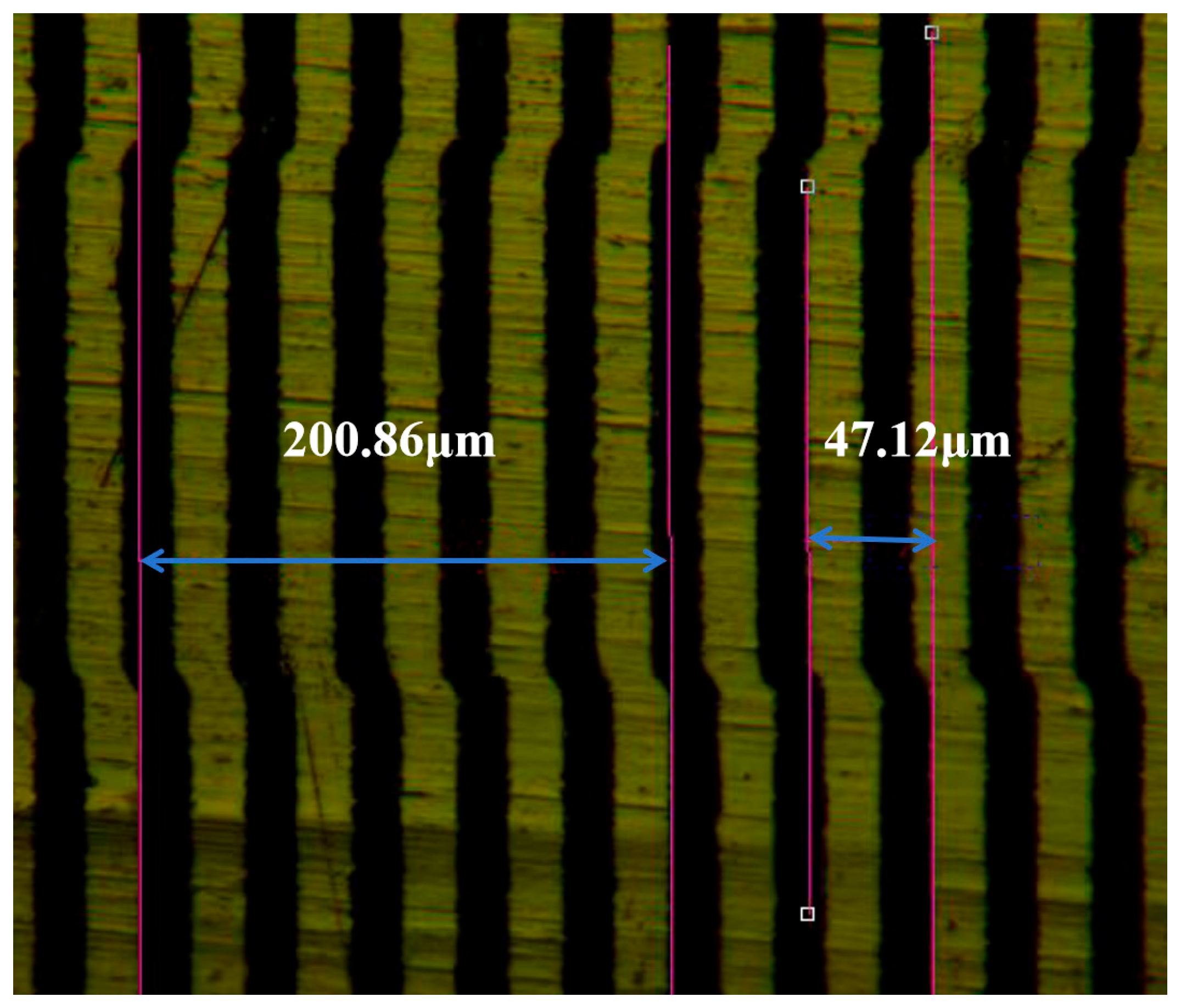
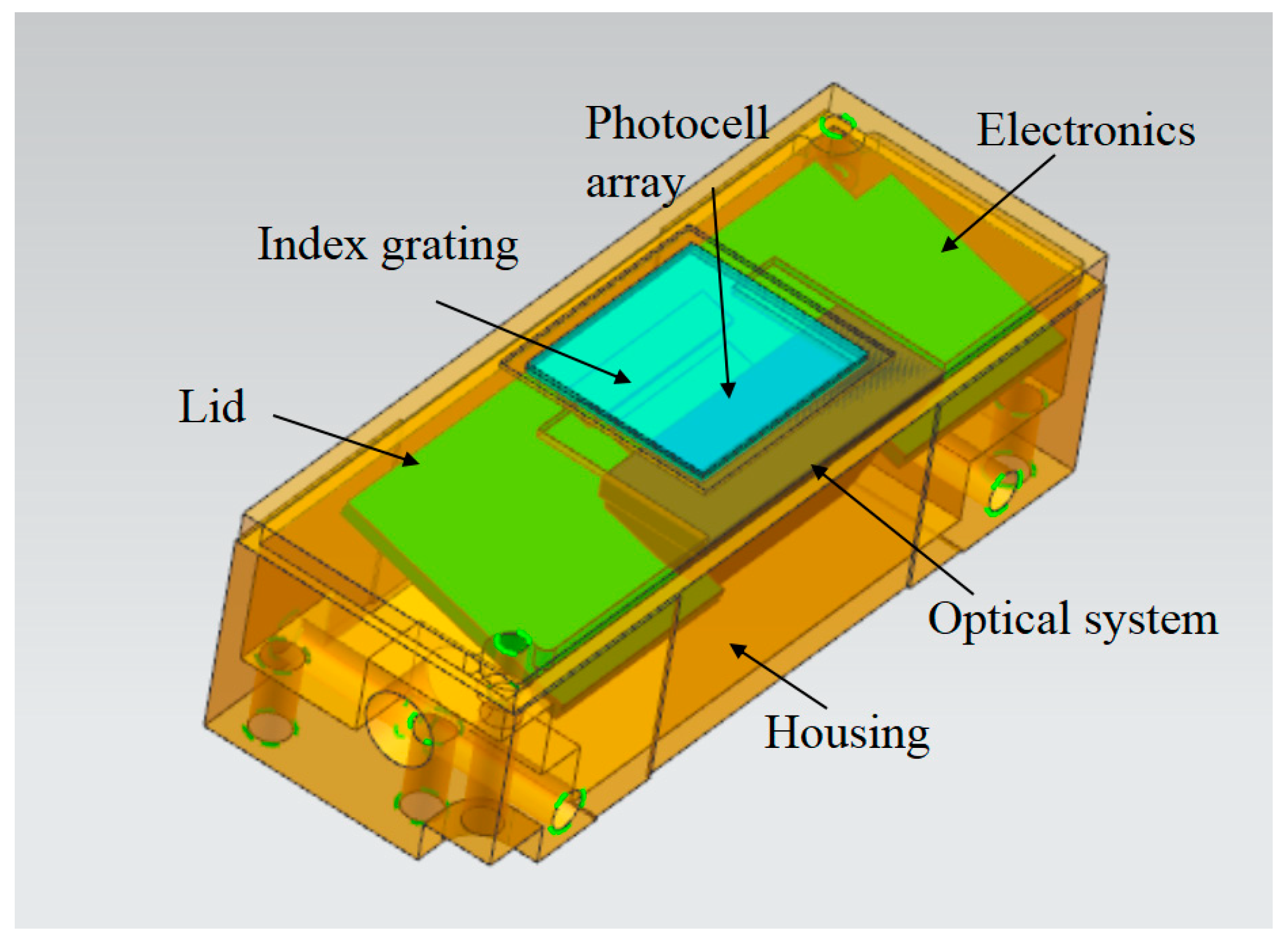


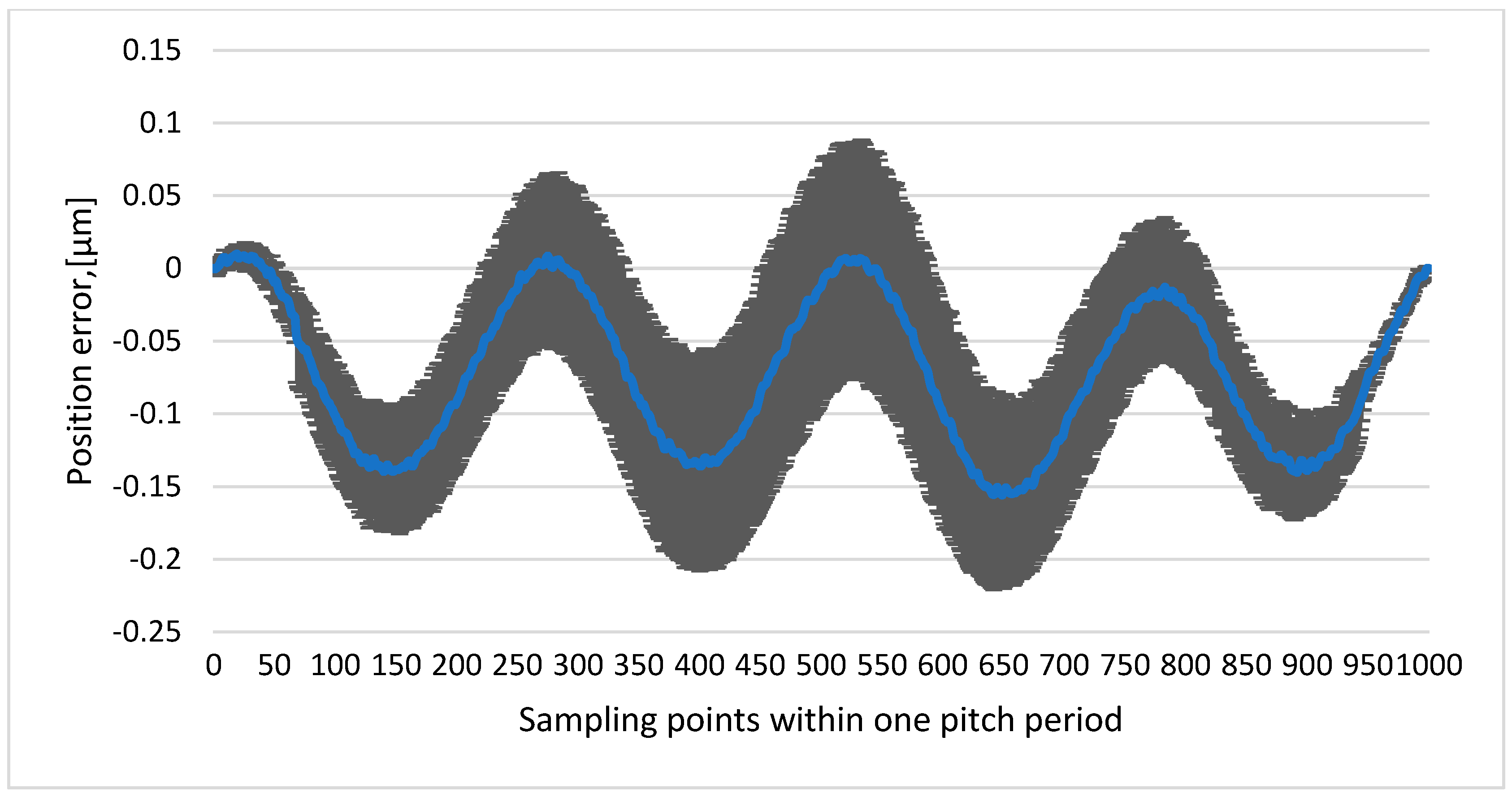
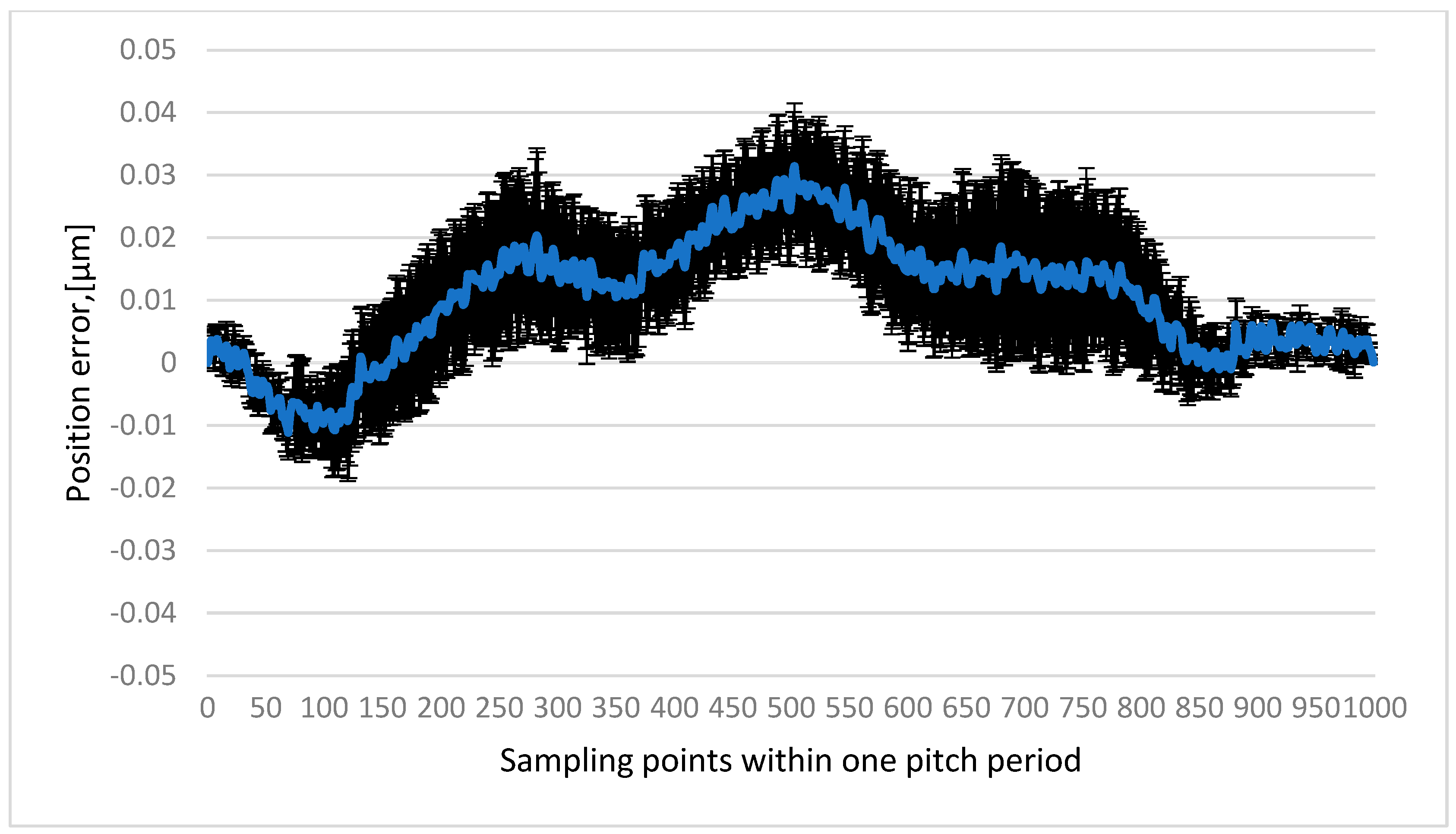
| Main Scales | Traditional Main Scale | Proposed Main Scale |
|---|---|---|
| The content of third order harmonics in 6 examined pitch periods | 2.27% | 0.13% |
| 1.58% | 0.09% | |
| 2.31% | 0.04% | |
| 2.18% | 0.08% | |
| 2.07% | 0.12% | |
| 2.00% | 0.05% | |
| Average value | 2.07% | 0.09% |
Disclaimer/Publisher’s Note: The statements, opinions and data contained in all publications are solely those of the individual author(s) and contributor(s) and not of MDPI and/or the editor(s). MDPI and/or the editor(s) disclaim responsibility for any injury to people or property resulting from any ideas, methods, instructions or products referred to in the content. |
© 2024 by the authors. Licensee MDPI, Basel, Switzerland. This article is an open access article distributed under the terms and conditions of the Creative Commons Attribution (CC BY) license (https://creativecommons.org/licenses/by/4.0/).
Share and Cite
Lu, X.; Yang, F.; Kilikevičius, A. A Method for Reducing Sub-Divisional Errors in Open-Type Optical Linear Encoders with Angle Shift Pattern Main Scale. Mathematics 2024, 12, 474. https://doi.org/10.3390/math12030474
Lu X, Yang F, Kilikevičius A. A Method for Reducing Sub-Divisional Errors in Open-Type Optical Linear Encoders with Angle Shift Pattern Main Scale. Mathematics. 2024; 12(3):474. https://doi.org/10.3390/math12030474
Chicago/Turabian StyleLu, Xinji, Fan Yang, and Artūras Kilikevičius. 2024. "A Method for Reducing Sub-Divisional Errors in Open-Type Optical Linear Encoders with Angle Shift Pattern Main Scale" Mathematics 12, no. 3: 474. https://doi.org/10.3390/math12030474
APA StyleLu, X., Yang, F., & Kilikevičius, A. (2024). A Method for Reducing Sub-Divisional Errors in Open-Type Optical Linear Encoders with Angle Shift Pattern Main Scale. Mathematics, 12(3), 474. https://doi.org/10.3390/math12030474





